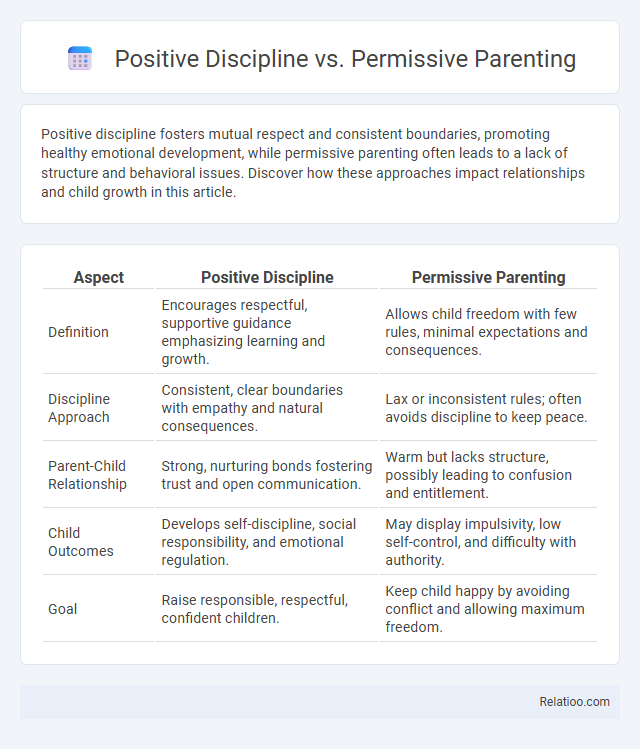Positive discipline fosters mutual respect and consistent boundaries, promoting healthy emotional development, while permissive parenting often leads to a lack of structure and behavioral issues. Discover how these approaches impact relationships and child growth in this article.
Table of Comparison
| Aspect | Positive Discipline | Permissive Parenting |
|---|---|---|
| Definition | Encourages respectful, supportive guidance emphasizing learning and growth. | Allows child freedom with few rules, minimal expectations and consequences. |
| Discipline Approach | Consistent, clear boundaries with empathy and natural consequences. | Lax or inconsistent rules; often avoids discipline to keep peace. |
| Parent-Child Relationship | Strong, nurturing bonds fostering trust and open communication. | Warm but lacks structure, possibly leading to confusion and entitlement. |
| Child Outcomes | Develops self-discipline, social responsibility, and emotional regulation. | May display impulsivity, low self-control, and difficulty with authority. |
| Goal | Raise responsible, respectful, confident children. | Keep child happy by avoiding conflict and allowing maximum freedom. |
Understanding Positive Discipline
Understanding positive discipline involves setting clear boundaries while promoting respect and empathy, contrasting sharply with permissive parenting's lack of consistent rules and emphasis on child autonomy. Positive discipline encourages problem-solving and natural consequences, fostering long-term self-discipline rather than immediate compliance. Research shows children raised with positive discipline exhibit higher emotional regulation and social competence compared to those from permissive households.
Defining Permissive Parenting
Permissive parenting is characterized by a lenient approach where parents set few rules and allow their children considerable freedom, often avoiding confrontation or discipline. Unlike positive discipline, which emphasizes setting clear boundaries and encouraging responsible behavior through guidance and consistency, permissive parenting may lead to challenges in establishing limits and promoting self-regulation. Your understanding of these styles helps in choosing effective parenting strategies that balance nurturing support with necessary structure.
Core Principles of Positive Discipline
Positive Discipline centers on mutual respect, encouragement, and teaching children problem-solving skills to foster self-discipline and responsibility. It contrasts with Permissive Parenting, which often lacks consistent boundaries and emphasizes child autonomy without guidance, potentially leading to behavioral issues. Core Principles of Positive Discipline include establishing clear, firm limits with empathy, promoting positive communication, and encouraging children to understand the consequences of their actions through natural and logical consequences.
Key Traits of Permissive Parenting
Permissive parenting is characterized by high responsiveness and low demandingness, where parents exhibit warmth and affection but set few rules or boundaries. Children raised with permissive parents often experience inconsistent discipline, leading to challenges in self-regulation and authority respect. This parenting style contrasts with positive discipline, which balances firm boundaries with emotional support, promoting responsibility and self-discipline in children.
Impact on Child Development
Positive discipline fosters self-regulation and emotional intelligence by setting clear boundaries and encouraging responsibility, which promotes healthy child development. Permissive parenting often leads to challenges in impulse control and social behavior due to lack of consistent rules, negatively impacting a child's long-term growth. Your choice of parenting style significantly influences your child's ability to develop resilience and effective decision-making skills.
Setting Boundaries: Structure vs. Leniency
Setting boundaries in positive discipline emphasizes consistent structure and clear expectations, fostering a supportive environment where Your child learns self-regulation and responsibility. Permissive parenting leans towards leniency, often resulting in fewer rules and less guidance, which can lead to challenges in behavior management. Positive discipline balances firmness with empathy, promoting mutual respect while maintaining necessary limits to guide healthy development.
Emotional Outcomes in Children
Positive discipline promotes emotional regulation and resilience by setting clear boundaries while nurturing empathy, leading to secure attachment and higher self-esteem in children. Permissive parenting often results in children struggling with emotional control and impulsivity due to a lack of consistent limits, increasing susceptibility to anxiety and behavioral issues. In contrast, authoritative positive discipline supports emotional growth through consistent, nurturing guidance, fostering better social skills and emotional intelligence.
Long-term Behavioral Effects
Positive discipline fosters long-term behavioral growth by teaching children self-regulation, accountability, and empathy through consistent boundaries and positive reinforcement, resulting in responsible and emotionally resilient adults. Permissive parenting often leads to challenges in self-control and authority respect, increasing the risk of behavioral issues due to a lack of clear limits. Your choice of discipline style profoundly impacts your child's future social skills and emotional well-being, making positive discipline the most effective for sustained positive outcomes.
Strategies for Effective Parenting
Positive discipline employs clear, consistent boundaries and promotes mutual respect while using natural consequences to guide behavior, fostering self-discipline and accountability in children. Permissive parenting lacks firm limits, often resulting in inconsistent rules and challenges with authority, which can undermine a child's ability to develop self-control. Effective parenting strategies prioritize positive discipline by balancing empathy with structure, encouraging cooperation through positive reinforcement, and teaching problem-solving skills to support long-term emotional growth and responsible decision-making.
Choosing the Best Approach for Your Family
Positive discipline emphasizes clear boundaries and respectful communication, fostering long-term self-discipline, while permissive parenting often lacks consistent rules, which can lead to behavioral challenges. Evaluating your family's values and children's needs helps determine whether a structured yet nurturing approach like positive discipline or a more lenient style suits you best. Your choice impacts your child's development, emotional growth, and ability to manage challenges effectively.

Infographic: Positive discipline vs Permissive parenting
 relatioo.com
relatioo.com